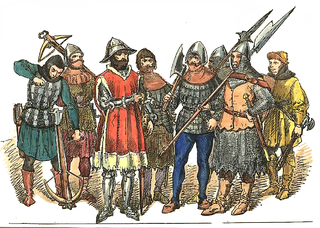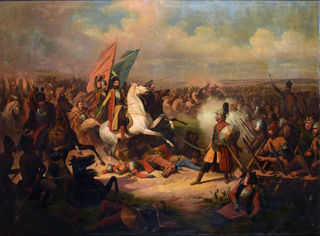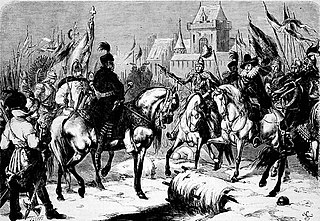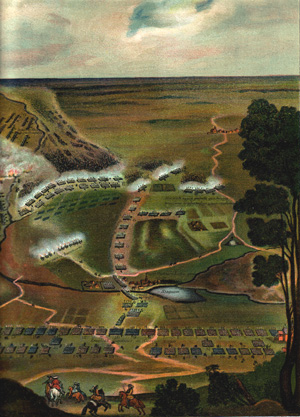
The Battle of Świecino also called the Battle of Żarnowiec or in German Die Schlacht bei Schwetz, took place on September 17, 1462, during the Thirteen Years' War. The Polish forces, commanded by Piotr Dunin and consisting of some 2,000 mercenaries and Poles, decisively defeated the 2,700-man army of the Teutonic Knights, commanded by Fritz Raweneck and Commander of the Order Kaspar Nostitz (Nostyc). Auxiliary forces sent by Duke Eric II of Pomerania, temporary ally of the Teutonic Knights, did not enter the battle.

Stephen Báthory was Voivode of Transylvania (1571–1576), Prince of Transylvania (1576–1586), King of Poland and Grand Duke of Lithuania (1576–1586).

The Battle of Klushino, or the Battle of Kłuszyn, was fought on 4 July 1610, between forces of the Polish–Lithuanian Commonwealth and the Tsardom of Russia during the Polish–Russian War, part of Russia's Time of Troubles. The battle occurred near the village of Klushino near Smolensk. In the battle the outnumbered Polish-Lithuanian force secured a decisive victory over Russia, due to the tactical competence of hetman Stanisław Żółkiewski and the military prowess of Polish hussars, the elite of the army of the Crown of the Kingdom of Poland. The battle is remembered as one of the greatest triumphs of the Polish-Lithuanian cavalry and an example of excellence and supremacy of the Polish-Lithuanian military at the time.

The Battle of Kircholm was one of the major battles in the Polish–Swedish War of 1600–1611. The battle was decided in 20 minutes by a devastating charge of Polish-Lithuanian cavalry, including the Winged Hussars. The battle ended in a decisive victory of the Polish-Lithuanian forces, and is remembered as one of the greatest triumphs of Commonwealth cavalry.

The Battle of Lwów or Battle of Lesienice or Battle of Lviv refers to a battle between the armies of Polish–Lithuanian Commonwealth and Ottoman Empire that took place near the city of Lwów on August 24, 1675.

The Battle of Polonka took place near Polonka during the Polish-Russian War (1658-1667) on 29 June 1660 between Polish-Lithuanian and Russian forces. Polish-Lithuanian army under Stefan Czarniecki and Paweł Jan Sapieha forced a Russian retreat through a carefully planned Polish hussar ambush and several tactically effective flanking maneuvers. The Russian defeat also meant they had to abandon the Siege of Lyakhavichy (Lachowicze).

The Battle of Byczyna, also known as the Battle of Pitschen, was the deciding battle of the 1587–1588 War of the Polish Succession, which erupted after two rival candidates were elected to the Polish throne. The two opposing sides had forces nearly evenly matched, with armies about 6,000 strong, roughly half infantry and half cavalry. The battle was an overwhelming victory for the Polish-Swedish faction, led by the Swedish-born king-elect Sigismund III Vasa, over the army of his rival to the throne, Maximilian III, Archduke of Austria.

The Battle of Obertyn was fought between Moldavian Voivode Petru Rareş and Polish forces under hetman Jan Tarnowski, in the town of Obertyn, south of the Dniester River, now in Ukraine. The battle ended with a Polish victory and the reconquest of Pokutia.

The Polish–Swedish War of 1626–1629 was the fourth stage in a series of conflicts between Sweden and Poland fought in the 17th century. It began in 1626 and ended four years later with the Truce of Altmark and later at Stuhmsdorf with the Treaty of Stuhmsdorf.

The Polish hussars, alternatively known as the winged hussars, were a heavy cavalry formation active in Poland and in the Polish–Lithuanian Commonwealth from 1503 to 1702. Their epithet is derived from large rear wings, which were intended to demoralize the enemy during a charge. The hussars ranked as the elite of Polish cavalry until their official disbanding in 1776.

The Battle of Kłecko was fought on May 7, 1656, between forces of the Polish–Lithuanian Commonwealth commanded by Regimentarz Stefan Czarniecki and Jerzy Sebastian Lubomirski and a Swedish force commanded by prince Adolf Johan av Pfalz-Zweibrücken. The Polish–Lithuanian force was more than 12,000 strong and consisted mostly of cavalry, while the Swedes numbered around 7,000 artillery, infantry and cavalry. The Swedes achieved a tactical victory in that they escaped destruction by the Poles, who were unable to get to the Swedish army entrenched behind the Welnianka River, and various ditches and swamps. Swedish army lost 428 dead, while the Polish army sustained 70 dead and wounded, 2,000 dead or 3,000 dead, including 40 companions dead.

The Battle of Khotyn or Battle of Chocim or Khotyn War was a combined siege and series of battles which took place from 2 September to 9 October 1621 between a Polish-Lithuanian army with Cossack allies, commanded by the Grand Hetman of Lithuania Jan Karol Chodkiewicz and Petro Konashevych-Sahaidachny, against an invading Ottoman Imperial army, led by Sultan Osman II, which was stopped until the first autumn snows. On 9 October, due to the lateness of the season and heavy losses - due to failed assaults on Commonwealth fortifications - the Ottomans abandoned their siege and the battle concluded with a stalemate, which is reflected in the treaty where some sections favour the Ottomans while others favoured the Commonwealth. Chodkiewicz died on 24 September 1621 shortly before concluding a treaty with the Turks.

The Battle of Khotyn or Battle of Chocim, also known as the Hotin War, took place on 11 November 1673 in Khotyn, where the forces of the Polish–Lithuanian Commonwealth under the Grand Hetman of the Polish Crown John Sobieski defeated Ottoman Empire forces, with Moldavian and Wallachian regiments, led by Hüseyin Pasha. It reversed the fortunes of the previous year, when Commonwealth weakness led to the signing of the Treaty of Buchach, and allowed John Sobieski to win the upcoming royal election and become the King of Poland.
The siege of Danzig was a six-month siege in 1577 of the city of Danzig, the Polish–Lithuanian Commonwealth by Stephen Báthory, the head of state of the Commonwealth. The siege ended in a negotiated agreement. It formed part of the Danzig rebellion.
The rebellion of the city of Danzig (Gdańsk) was a revolt from December 1575 to December 1577 of the city against the outcome of the 1576 Polish–Lithuanian royal election. The Polish throne was contested by Stephen Báthory and the Holy Roman Emperor Maximillian II.
The Battle of Kokenhausen was a major battle opening the Polish–Swedish War (1600–1611). It took place on the 13 June (O.S.) or 23 June (N.S.) 1601 near Koknese in Livonia. In the battle, Polish forces defeated the Swedish relief force and captured the besieging force, relieving the Polish garrison. The battle is notable as one of the greatest victories of the Polish hussars, who defeated their numerically superior Swedish adversaries.

The Livonian campaign of Stephen Báthory took place in the final stage of the Livonian War, between 1577 and 1582. Polish-Lithuanian forces led by Stephen Báthory, King of Poland and Grand Duke of Lithuania, successfully fought against the army of Ivan IV "the Terrible", Tsar of Russia, over the Duchy of Livonia and Polotsk. Russian forces were expelled from Livonia before the campaign was concluded by the Truce of Jam Zapolski.
The Battle of Gniew or the Battle of Mewe was fought during the Polish–Swedish War (1626–1629), between Sweden and the Polish–Lithuanian Commonwealth from 22 September with initial skirmishes, to the main battle of October 1 1626. Both the Swedish and Polish army were commanded by their kings – Gustavus Adolphus of Sweden and Sigismund III Vasa. The battle ended indecisively. However, Polish and Swedish armies had different objectives. Sigismund Vasa wanted to protect Gdańsk from besieging. Gustav had to protect Gniew, which was important for the prestige of his army. The battle ended in a Swedish victory.
The Battle of Dirschau took place in the summer of 1627 and was one of the battles of the Polish–Swedish War (1626–29). The Polish forces led by Crown Field Hetman Stanisław Koniecpolski met with troops commanded by Swedish King Gustavus Adolphus of Sweden. Gustavus Adolphus was wounded in the battle, which ended inconclusively. Fighting in Prussia ended in a stalemate for that year, and would not resume until 1628.
The Battle of Weissenstein, or Battle of Biały Kamień, was fought during the Polish–Swedish War (1600–1611), between Sweden and the Polish–Lithuanian Commonwealth on 25 September 1604. The Swedish army was commanded by Arvid Stålarm and the Polish army under Jan Karol Chodkiewicz. The battle ended with a victory for Poland, who sent a relief party against the Swedish forces which besieged Weissenstein castle, modern day Paide in Estonia.

















